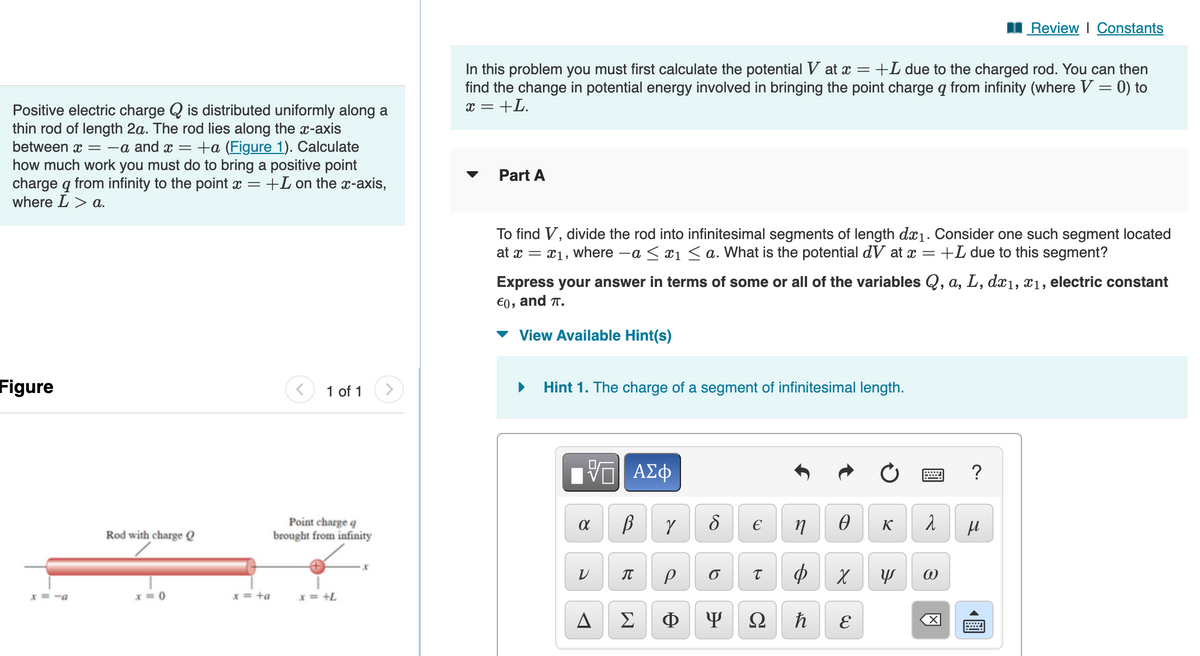Positive electric charge Q is distributed uniformly along a thin rod of length 2a. The rod lies along the x-axis between x = -a and x = +a (Figure 1). Calculate how much work you must do to bring a positive point charge q from infinity to the point x = +L on the x-axis, where L > a. igure Rod with charge Q x=0 x=+a 1 of 1 Point charge q brought from infinity x=+L In this problem you must first calculate the potential V at x = +L due to the charged rod. You can then find the change in potential energy involved in bringing the point charge q from infinity (where V = 0) to x = +L. Part A To find V, divide the rod into infinitesimal segments of length dx₁. Consider one such segment located at x = x₁, where -a ≤ x ≤a. What is the potential dV at x = +L due to this segment? Express your answer in terms of some or all of the variables Q, a, L, dx₁, ₁, electric constant €0, and T. ▾ View Available Hint(s) ▶ Hint 1. The charge of a segment of infinitesimal length. 15| ΑΣΦ В Y α V A π Σ P Φ 8 σ Y € T Ω n Ф ħ Ꮎ X E K y 2 @ Review Constants X ? μ
Positive electric charge Q is distributed uniformly along a thin rod of length 2a. The rod lies along the x-axis between x = -a and x = +a (Figure 1). Calculate how much work you must do to bring a positive point charge q from infinity to the point x = +L on the x-axis, where L > a. igure Rod with charge Q x=0 x=+a 1 of 1 Point charge q brought from infinity x=+L In this problem you must first calculate the potential V at x = +L due to the charged rod. You can then find the change in potential energy involved in bringing the point charge q from infinity (where V = 0) to x = +L. Part A To find V, divide the rod into infinitesimal segments of length dx₁. Consider one such segment located at x = x₁, where -a ≤ x ≤a. What is the potential dV at x = +L due to this segment? Express your answer in terms of some or all of the variables Q, a, L, dx₁, ₁, electric constant €0, and T. ▾ View Available Hint(s) ▶ Hint 1. The charge of a segment of infinitesimal length. 15| ΑΣΦ В Y α V A π Σ P Φ 8 σ Y € T Ω n Ф ħ Ꮎ X E K y 2 @ Review Constants X ? μ
Chapter5: Electric Charges And Fields
Section: Chapter Questions
Problem 101P: In this exercise, you practice electric field lines. Make sure you represent both the magnitude and...
Related questions
Question
100%
Positive electric charge Q is distributed uniformly along a thin rod of length 2a. The rod lies along the x-axis between x=−a and x=+a (Figure 1). Calculate how much work you must do to bring a positive point charge q from infinity to the point x=+L on the x-axis, where L>a.

Transcribed Image Text:Positive electric charge is distributed uniformly along a
thin rod of length 2a. The rod lies along the x-axis
between x = -a and x = +a (Figure 1). Calculate
how much work you must do to bring a positive point
charge q from infinity to the point x = +L on the x-axis,
where L > a.
Figure
x=-a
Rod with charge Q
x=0
x = +a
< 1 of 1
Point charge q
brought from infinity
x = +L
x
In this problem you must first calculate the potential V at x = +L due to the charged rod. You can then
find the change in potential energy involved in bringing the point charge q from infinity (where V = 0) to
x = +L.
Part A
To find V, divide the rod into infinitesimal segments of length dx₁. Consider one such segment located
at x = x₁, where -a ≤ x₁ ≤ a. What is the potential dV at x = +L due to this segment?
Express your answer in terms of some or all of the variables Q, a, L, dx₁, x₁, electric constant
€0, and T.
View Available Hint(s)
Hint 1. The charge of a segment of infinitesimal length.
VE ΑΣΦ
В
α
V
R
A Σ
Y
P
Φ
8
6
Y
€
T
Ω
n
Φ
ħ
Ꮎ
X
E
K
=
λ
Y @
X
Review | Constants
?
μ
www
Expert Solution
This question has been solved!
Explore an expertly crafted, step-by-step solution for a thorough understanding of key concepts.
This is a popular solution!
Trending now
This is a popular solution!
Step by step
Solved in 2 steps with 2 images

Follow-up Questions
Read through expert solutions to related follow-up questions below.
Follow-up Question
What does your result for the potential energy U(x=+L) become in the limit a→0?
Solution
Knowledge Booster
Learn more about
Need a deep-dive on the concept behind this application? Look no further. Learn more about this topic, physics and related others by exploring similar questions and additional content below.Recommended textbooks for you

